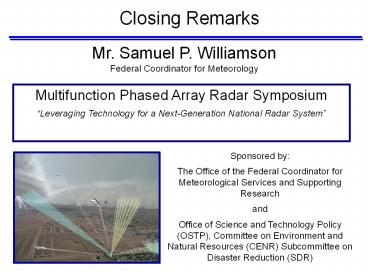Mr. Samuel P. Williamson - PowerPoint PPT Presentation
1 / 15
Title:
Mr. Samuel P. Williamson
Description:
Title: No Slide Title Author: OFCM Last modified by: weadon Created Date: 7/17/2000 7:13:09 PM Document presentation format: On-screen Show Company – PowerPoint PPT presentation
Number of Views:124
Avg rating:3.0/5.0
Title: Mr. Samuel P. Williamson
1
Closing Remarks
Mr. Samuel P. Williamson Federal Coordinator for
Meteorology
Multifunction Phased Array Radar
Symposium Leveraging Technology for a
Next-Generation National Radar System
Sponsored by The Office of the Federal
Coordinator for Meteorological Services and
Supporting Research and Office of Science and
Technology Policy (OSTP), Committee on
Environment and Natural Resources (CENR)
Subcommittee on Disaster Reduction (SDR)
2
Overview
- Symposium Demographics
- Symposium Objectives
- Overarching Requirements
- Fundamental Message / Outcome
- Action Items and Way Ahead
- Presentation Availability
- Feedback
- Special Recognition
- Thank You
3
Symposium Demographics
- 181 Total Participants
Percent Participation
4
Symposium Objectives
- Highlight future user PAR requirements and
summarize benefits derived from PARs adaptive
scanning capability - Explore implementation of RD priorities laid out
in the June 2006 Interagency JAG/PAR report,
accounting for (1) work already accomplished
(2) items that still need additional focus and
(3) potential alternative configurations - Gather perspective from the radar industry on the
state of the technology, the technological
uncertainties, and the challenges of delivering
affordable phased array radar systems in the
future - Develop the way ahead to address MPAR
risk-reduction challenges through an
implementation strategy and interagency
management approach
5
Overarching Requirements
- Overarching Requirements
- No gaps to current capability
- Improve forecasts and lead time
- Backup to FAA NAS
- Non-cooperative surveillance throughout the NAS
- Reduce life cycle costs
- Specified / detailed requirements documented in
report, Federal Research and Development Needs
and Priorities for Phased Array Radar - Requirements will continue to be refined /
updated
6
Fundamental Message / Outcome
- Now is the time to begin evaluation of MPAR need
risk-reduction implementation strategy - Legacy surveillance radars nearing end of life
cycle - Society demands greater protection of life and
property - More timely warnings of hazardous weather events
increased accuracy, spatial resolution and lead
times - Need for enhanced capability to track
non-cooperative aircraft and other airborne
threats to safety and national security - Multifunction capability leads to reduced life
cycle costs - Risk-reduction implementation strategy will
reduce uncertainties and produce cost-effective
alternatives - Leads to sound business case
7
Actions and Way Ahead
- Place all presentation materials on symposium
website for maximum accessibility - Develop an interagency management approach for
the MPAR risk-reduction activities, considering
the management approach used for the NEXRAD
program and also other options - The OFCM-sponsored Working Group for
Multifunction Phased Array Radar (WG/MPAR) needs
to develop a risk-reduction implementation
strategy
8
Actions and Way Ahead (cont)
- - Risk-reduction implementation strategy should
- Leverage military RD (e.g., Space and Naval
Warfare Systems Center, San Diego AFRL, ONR,
NRL) - Reach out to critics
- Enhance outreach and education efforts, including
opportunities to - Participate and/or present at meetings /
workshops - (e.g., AMS, IEEE, AAAS, AGU, ATA, AOPA, RTCA,
WGA, - WMO, ICAO)
- Be included in magazines / publications
- Link with other communities, like the wildland
fire community - Conduct additional MPAR workshops / symposia
- Reach out to potential industry partners
- Conduct technology interchange meetings
- Inform/update agency senior leadership, and OMB
and - OSTP representatives
9
Actions and Way Ahead (cont)
- - Risk-reduction implementation strategy should
- Involve both federal laboratories and industry
- -- Federal laboratories roles and missions
labs are in - the position, due to their expertise, to
make - recommendations on risks and areas of
research and - development also able to perform some RD
(advanced - development
- -- Conduct technology demonstration
projects - -- Industry potential roles and missions
- -- Develop alternative system design
approach (cost- - effective alternative(s)
- -- Production feasibility study (results
evaluated by - government
- -- Acquisition and logistics / maintenance
(life-cycle costs)
10
Action Items and Way Ahead
-- Industry potential roles and missions
(cont)
- -- Tests required to evaluate capability tests
need to - be clearly identified
- -- Future trade-off studies regarding
uncertainties - -- Site surveys and geographical coverage of
MPAR - -- Facilities analysis / requirements (towers,
etc.) - -- Frequency allocation analysis
- -- Acquisition approach alternatives best
course of - action to acquire system (four phases? two
- phases?)
11
Presentation Availability
- Presentations and other material will be
available on the OFCM web site shortly after the
symposium. - Click on Special Projects and navigate to
Multifunction Phased Array Radar Symposium
http//www.ofcm.gov/
12
FEEDBACK IS WELCOME
Samuel.Williamson_at_noaa.gov Mark.Weadon_at_noaa.gov (
301) 427-2002
13
Special Recognition
- The University of Oklahoma
- Participants
- Moderators / Panelists / Rapporteurs
- Luncheon Speaker
- NSSL / OFCM / STC Staff
- National Weather Center
- Media Support
14
Thank You!
Thank you for attending and participating in this
symposium!
On behalf of the Office of the Federal
Coordinator for Meteorology
Have a safe trip home...
And Thanks Again!
15
Multifunction Phased Array Radar Symposium
Leveraging Technology for a Next-Generation
National Radar System
October 10-12, 2007































